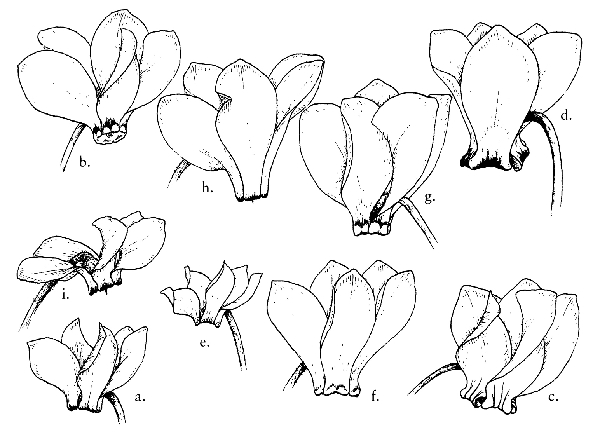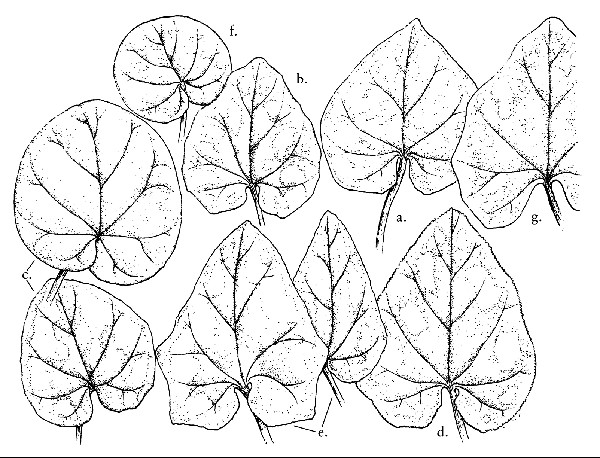Some 19 species of tuberous-rooted perennials distributed primarily in the Mediterranean region from northwestern Africa, the Balearic Islands, through much of southern Europe to Turkey, Cyprus and the eastern Mediterranean, east to the Caucasus and Elburz mountains, with an outlier in northern Somalia. They are species of woodland, scrub and rocky places, growing in sunny or partially shaded places, mostly subjected to long dry, warm or hot, summers. They have corm-likerounded, often somewhat flattened, tubers, rooting from below or on the sides or shoulders. Leaves alternate, arising directly from points on the upper surface of the tuber, or from the ends of woody subterranean 'trunks', long-stalked, the blades kidney-shaped to rounded or heart-shaped, entire or variously toothed, angled or lobed, green and often marbled above, frequently pink or purplish beneath. Flowers solitary, scapose, nodding, the pedicels glandular, generally coiling as the fruits develop. There are five strongly reflexed petals generally twisted and fused together below into a short tube, with or without well marked auricles at the point of reflexion. Stamens five forming a close cone around the solitary style. Fruit-capsule fleshy, subglobose, splitting irregularly in the upper half into five to seven recurved teeth. Seeds relatively large, sugary-coate
All species make useful and often delightful pan plants in the alpine house or frame. The less hardy ones require protection from severe frost. The hardier types are excellent in the open garden - on the rock garden, in woodland or raised beds, often seeding themselves around once established. The hardiest are C. cilicium, C. coum, C. hederifolium, C. purpurascens and some forms of C. repandum. The least hardy which require frost protection are C. africanum, C. persicum and C. rohlfsianum. The remainder fall between these two extremes in hardiness. All species require a well drained soil or compost. The compost, if loam-based, should have ample grit or Perlite added to ensure good drainage. A reliable compost is one part leaf-mould, one part sphagnum peat, one part sterilised loam and two parts coarse sand or grit. Cyclamen grown under glass need ample ventilation and an even temperature. Scorching sun and severe freezing may harm the hardiest when pot grown. The tuber should be planted with the top just exposed or covered with a thin layer of coarse grit. C. purpurascens, C. hederifolium and C. repandum, on the other hand, should be planted deeper in pans, about halfway down. In the garden, tubers can be planted deeper and respond well to annual top-dressings of leafmould and bonemeal. Seed is best gathered the moment it is ripe or just before the capsule splits, then sown immediately. Older seed is best soaked in warm water for twelve hours before sowing. Germination takes at least six weeks and up to fifteen or more. Seedlings are best left undisturbed until they become dormant in their second year. If they can be encouraged to keep growing right through their first season then so much the better. Only C. rohlfsianum requires completely drying out during the summer. At the other extreme C. parviflorum and C. purpurascens require moisture throughout the year. The remainder fall between these two extremes. Mature plants generally transplant better in full growth - just after flowering being ideal. Dried tubers, such as those often sold by garden centres, are often difficult to get into growth and may take two years to do so; overwatering during this period will often lead to rotting. Most of the species set seed fairly easily, although hand-pollination may sometimes be necessary, preferably transferring pollen from one plant to another of the same species. Hybrids between the species are rare (except in the C. repandum group) so interbreeding is unlikely to be a problem in a mixed collection. Some named cultivars come true from seed, but not all do so. Division of a tuber to increase a rare form is a risky business; each portion must bear some growing points as well as roots and the cut surface must be carefully treated with methylated spirits or fungicide to prevent infection.

a, C. cilicium; b, C. coum; c, C. graecum; d, C. hederifolium; e, C. intaminatum; f, C. libanoticum; g, C. pseudibericum; h, C. repandum subsp. repandum; i, C. trochopteranthum;

a, C. balearicum; b, C. cilicium; c, C. coum; d, C. graecum; e, C. hederifolium; f, C. intaminatum; g, C. libanoticum;
Sign up for our newsletter to receive our monthly update direct to your inbox. Featuring our latest articles and news.
Built by Atomic Smash

